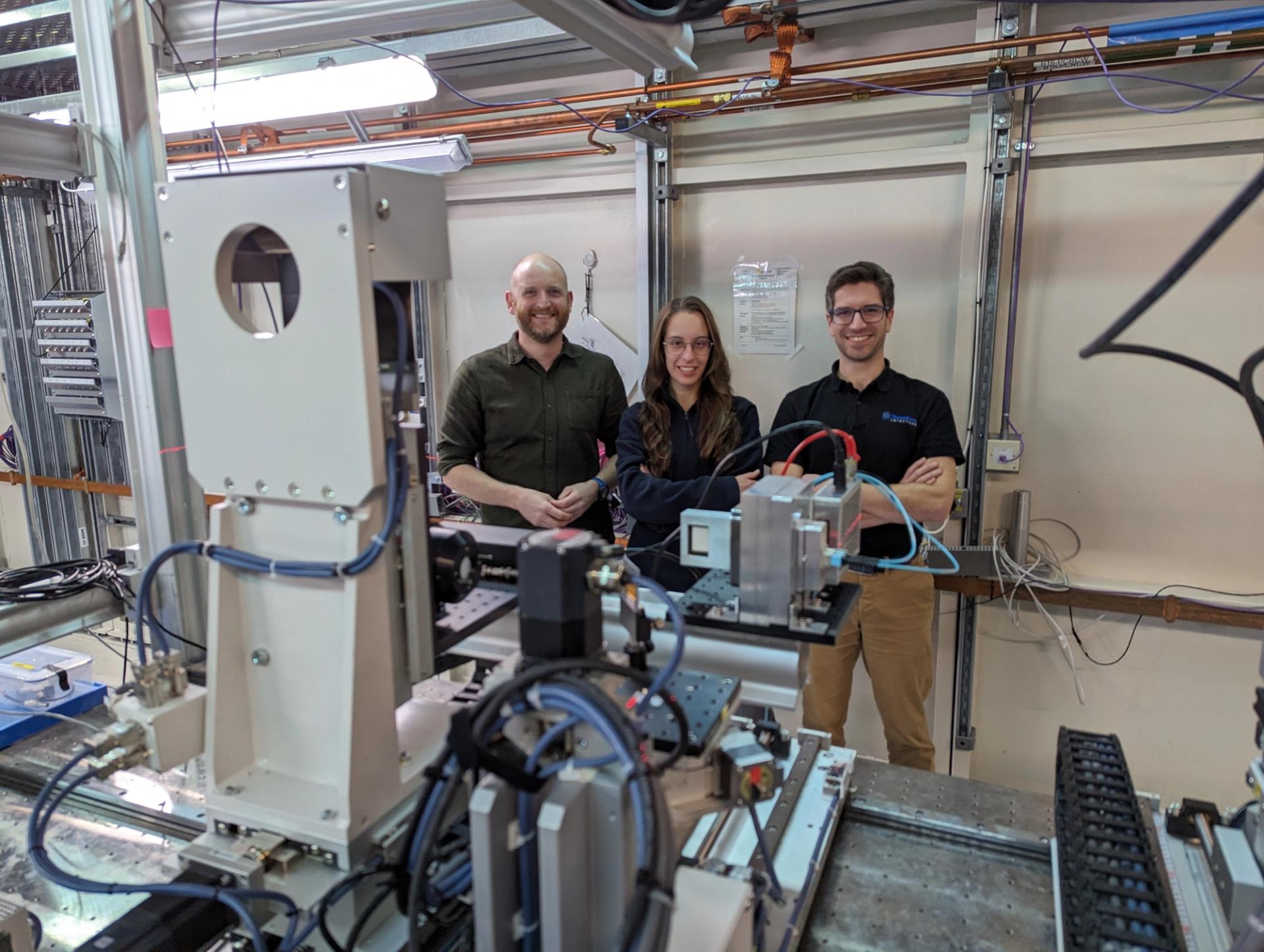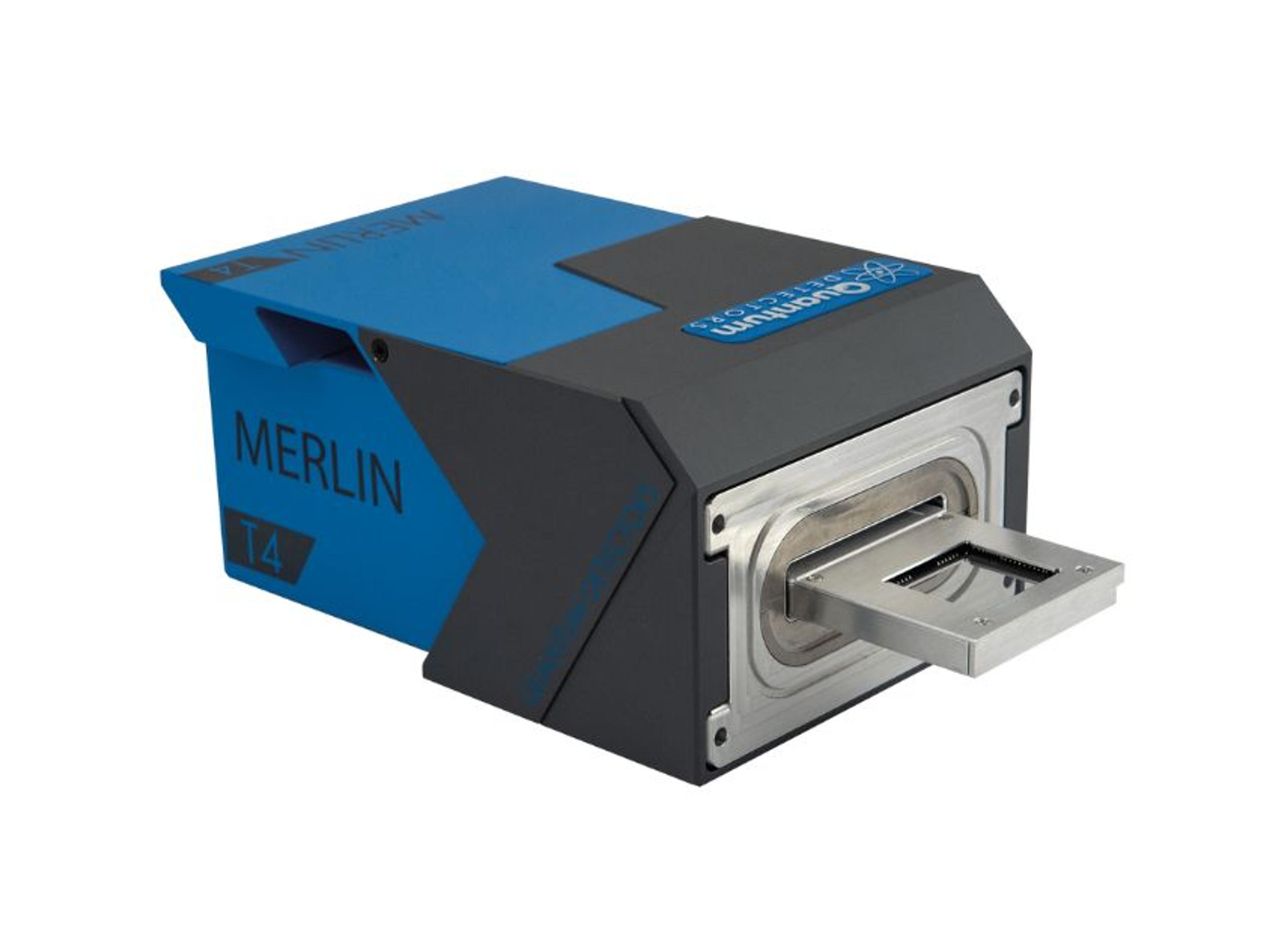Pixel-level tuning of Timepix4 advances detector technology
Oxford researcher Nina Dimova pushes pixel-by-pixel calibration and clustering to unlock nanosecond precision in particle tracking and electron microscopy
21 Oct 2025
Hybrid pixel detectors, first developed at CERN in the 1980s and 1990s to meet the demands of high-energy particle tracking, laid the groundwork for today’s most advanced imaging detectors. Timepix4, a new-generation programmable readout ASIC (application-specific integrated circuit), emerged from the Medipix4 collaboration between CERN, universities and research institutions around the world.

Nina Dimova, DPhil Particle Physics at the University of Oxford
Launched in 2016, the Medipix4 project produced two complementary chips: Medipix4 for spectroscopic X-ray imaging, and Timepix4 for high-precision particle tracking and timing. Designed using 65-nm CMOS technology and released in 2022, Timepix4 features a 448 × 512 pixel matrix with a 55 µm pixel pitch.
“Timepix4, which powers Quantum Detectors’ Merlin T4 hybrid pixel detector, offers impressive data rates, dynamic range, and timing resolution,” explains Nina Dimova, DPhil candidate in Particle Physics at the University of Oxford, UK. “However, applying it to smaller-scale measurements introduces new challenges.” The Medipix4 ASIC was the second chip to emerge from the Medipix4 collaboration, in 2023, and it targets spectroscopic X-ray imaging at rates compatible with medical CT scans. It was designed in a 130 nm CMOS technology and is a pixel detector read-out chip working in single counting mode.
Unlike earlier ASICs, where global corrections could be applied across the entire sensor matrix, Timepix4’s increased sensitivity, timing precision, and larger pixel array produce significant variation at the individual pixel level. As a result, calibrations must now be applied per pixel—across more than 230,000 data points. “This generates far richer and more accurate datasets,” says Dimova, “but it also means substantial storage and processing demands. Running clustering algorithms can take several days. My goal is to make the sensor more user-friendly so it can be used beyond specialized high-energy physics laboratories.”

(Left) Liam O'Ryan, Chief Technology Officer, at Quantum Detectors Ltd, (middle) Nina Dimova, DPhil Particle Physics at the University of Oxford, and (right) Giulio Crevatin, FPGA Engineer at Quantum Detectors Ltd
Applying the modulation transfer function
The modulation transfer function (MTF) is used to quantify the spatial resolution of any imaging system.
“When you are working with a lens or a continuous optical device, you can use the point spread function to characterize the spatial decision achieved by your device. In a pixelated device, you can’t look at the point spread directly, so we study the edge spread function, and mathematically go back to the point spread function and the MTF,” explains Dimova.
The edge spread function is the detector response to a physical knife edge projected onto the sensor. If this is projected perpendicular to the matrix, the measurement cannot account for aliasing. To avoid this, Dimova projects the knife edge at a slant to the pixel matrix, allowing the edge spread function to be sampled at different points in the edge cycle. This oversampling allows her to get an average MTF.
“Characterizing the MTF matters because in electron microscopy, imaging performance directly affects how reliably you can reconstruct or interpret structural information at the nanoscale,” she details. “These methods of characterizing detector performance feed directly into her work on improving spatial and temporal resolution.”
Improving spatial and temporal accuracy in electron microscopy
With its dual readout architecture, Timepix4 can operate in both frame-based and data-driven (event-based) modes. This flexibility allows researchers to capture 4D-STEM datasets at speeds comparable to conventional scanning transmission electron microscopy (STEM), while also recording individual events with nanosecond precision. The result is improved spatial resolution and the ability to observe dynamic nanoscale changes, for example, magnetic or structural transitions occurring over nanosecond timescales. Without corrections, for example, charge calibrations and time walk corrections, systematic errors can accumulate and distort measurements in any detector system, and this is even more critical at higher levels of resolution.
“When working at the nanosecond scale, calibration accuracy becomes critical,” Dimova emphasizes. “We’re actively refining this.” Her work also focuses on clustering, which improves effective spatial resolution by reducing the apparent pixel pitch, for instance, from 55 µm to ~27.5 µm through advanced data processing. This subpixel resolution could be advantageous for applications that benefit from a higher pixel density, protein crystallography and electron energy loss spectroscopy for example. “For charged particle beams, a single cluster may span tens of pixels,” she explains. “But for 100–300 kV electrons, clusters might only cover four to six pixels, providing less information. My aim is to make clustering as accurate as possible for electron applications.”
The next step for hybrid pixel detector technology
Dimova identifies data computation and analysis as a major bottleneck. She aims to simplify workflows, enabling researchers across disciplines to access the technology without extensive coding or informatics expertise.
“Building readouts for chips produced in the future will be challenging with the massive amounts of data produced and the huge data rate. To meet this challenge, Quantum Detectors is developing a readout for Timepix4. We may also need to ensure that physicists have a stronger background in data, or collaborate more with computer scientists, for example seeing whether they can support us with clustering.“
Much of Dimova’s research uses the Timepix4 ASIC coupled with a silicon sensor. These types of sensors generally exhibit fewer defects than those made with other materials. The Timepix4 design is also able to incorporate detectors of different thicknesses.
“I’ve worked with 300 µm silicon sensors, but thicker sensors open new opportunities for higher-energy particle detection,” says Dimova. “At Medipix meetings, we see many teams adapting the Timepix4 ASIC for specialized applications. Whatever the setup or specialized needs, it provides an extraordinary depth of information for every event and measurement. The potential is massive in terms of resolution – working together and bringing the right expertise in, we can make it more accessible and as user friendly as possible.”

